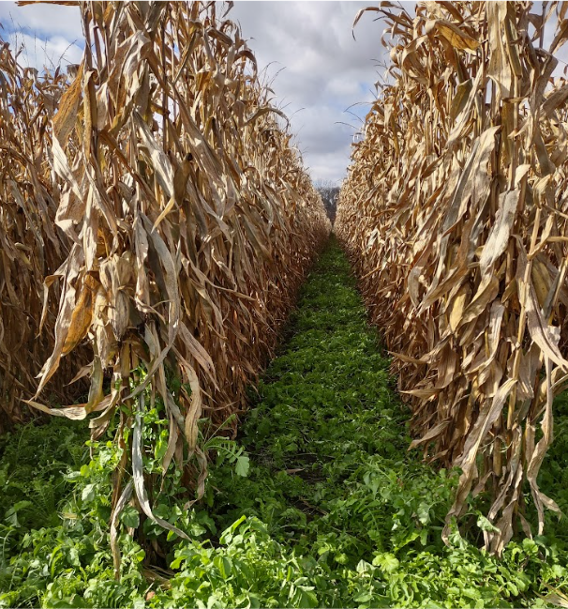There are many innovative ways to incorporate cover crops into a corn and soybean rotation
Editor’s note: This is an edited transcript of Keith Berns’ presentation from the 2023 Acres U.S.A. Eco-Ag Conference. Join us this December 2-5 in Madison, Wisconsin, for lots more in-depth content like this!

My brother and I grew up on a farm in southcentral Nebraska. We still farm a couple thousand acres there, and we started looking at cover crops back in 2006. In 2009 we decided to start a cover crop seed business — Green Cover Seeds. We stress education so much in what we do because we feel that if you understand what’s going on in the soil, the only conclusion you can come to is that you have to have a living plant — a living root — in the soil to make things work. And in most operations, unless you’re growing perennials, you’re going to need a cover crop to do that well.
Growers in a corn-bean rotation, in particular, often struggle to know how to integrate cover crops. We often hear people say, “I would’ve planted a cover crop, but harvest ran late, so we ran out of time.” I’d like to address this issue — while not belittling the fact that there is a crunch at that time of year. We raise a lot of corn and beans ourselves, so we understand.
But I’d like to share some of the many innovative ways that growers are including cover crops these days. The real problem is not that you run out of time; the real problem is that you simply lack diversity when you only have corn and beans. And even if you’re not in a strictly corn-bean rotation, a lot of these principles can still apply.
Strategies to Open the Window
I’m excited to announce that we have a new cover crop that’s going to be available coming soon. It overwinters great, but it’s not a challenge to control in the spring. You can plant it as late as you want. It fixes NP and K and any other nutrient you need. It’s going to grow tons of biomass, but it’s not going to be hard to plant into. It’s very inexpensive, and it fixes compaction, pH and salinity.
We call this new cover crop “Jack’s magic beans” — because as much as we all want a cover crop that meets what I just described, it doesn’t exist!
So, when we have a short window in between corn and beans, or whatever other crop, our goal is to try to open that window as much as possible. Here are a number of different strategies to make this happen.
Use short-season cash crop varieties. One strategy is simply to plant the shortest-season corn and soybean varieties possible without giving up significant yield. As Rick Clark says, “Do I give up yield to increase my soil health? You bet I do. I do it every day.” That’s a tradeoff he’s willing to make because he knows in the long run it’s going to work.

Now, with soybeans, you can go to much shorter varieties with almost no yield penalty. In fact, in our area — southern Nebraska — there are a lot of guys planting 3.2, 3.3 and 3.4 bean varieties, and some are going down to 2.4, 2.5, 2.6 beans and seeing no decrease in yield. Michigan State University did some research on bean varieties from 1.8 up to 2.9 and found that there wasn’t more than a two- or three-bushel yield difference between the variety groups. So, at least on part of your ground, go to shorter-season varieties. That gives you an opportunity to start planting cover crops sooner.
Plant fields that need cover crop help first. We like to use short-season varieties with corn as well. We identify which fields need the most help with cover crops and then plant those fields first with the shortest-season varieties. You can’t harvest everything all at once anyway; why would you plant all the same relative maturity? You can often pick up two weeks’ worth of cover crop growing season in the fall this way.
Support authors and subscribe to content
This is premium stuff. Subscribe to read the entire article.















